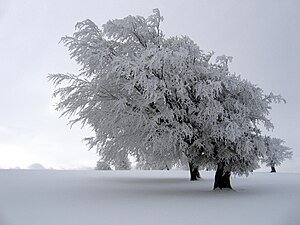Atmospheric icing

Atmospheric icing occurs in the atmosphere when water droplets suspended in air freeze on objects they come in contact with. It is not the same as freezing rain, which is caused directly by precipitation.
Icing conditions can be particularly dangerous to aircraft, as the built-up ice changes the aerodynamics of the flight surfaces and airframe, which can increase the risk of a stall and potentially accidents. For this reason, on-board ice protection systems have been developed on aircraft intended to fly through these conditions.
Water does not always freeze at 0 °C (32 °F). Water that persists in liquid state below this temperature is said to be supercooled, and supercooled water droplets cause icing on aircraft. Below −20 °C (−4 °F), icing is rare because clouds at these temperatures usually consist of ice particles rather than supercooled water droplets. Below −48 °C (−54 °F), supercooled water always freezes; therefore, icing is impossible.[1]
Atmospheric icing also occurs on towers, wind turbines, boats, oil rigs, and trees. Unmanned aircraft are particularly sensitive to icing.[2] In cold climates, particularly those at higher elevations, atmospheric icing is common in winter as elevated terrain interacts with supercooled clouds that can cause icing on contact.[3] Ice loads are a major cause of catastrophic failures of overhead electrical power lines, as power lines can break under the sheer weight of accumulated ice. Therefore, estimation of maximum potential ice load is crucial in the structural design of power line systems to withstand ice loads,[4] and this can be done with numerical icing models and examples that include meteorological data.[5]
See also
[edit]References
[edit]- ^ Moore, Emily; Valeria Molinero (24 November 2011). "structural transformation in supercooled water controls the crystallization rate of ice". Nature. 479 (7374): 506–508. arXiv:1107.1622. Bibcode:2011Natur.479..506M. doi:10.1038/nature10586. PMID 22113691. S2CID 1784703.
- ^ Hann, Richard; Johansen, Tor (2020). "Unsettled Topics in Unmanned Aerial Vehicle Icing (EPR2020008 Research Report) - SAE Mobilus". saemobilus.sae.org. doi:10.4271/epr2020008. hdl:11250/3113980. S2CID 226200723. Retrieved 2021-02-14.
- ^ Yang, Jing; Jones, Kathleen F.; Yu, Wei; Morris, Robert (2012-09-08). "Simulation of in-cloud icing events on Mount Washington with the GEM-LAM". Journal of Geophysical Research: Atmospheres. 117 (D17): n/a. Bibcode:2012JGRD..11717204Y. doi:10.1029/2012jd017520. ISSN 0148-0227.
- ^ Farzaneh, M. (2008) Atmospheric Icing of Power Networks. Springer Science & Business Media, 2008, 381 p. ISBN 978-1-4020-8530-7
- ^ Makkonen, L. (2000) Models for the growth of rime, glaze, icicles and wet snow deposits on structures. Philosophical Transactions of the Royal Society of London A, 358 (1776): 2913-2939.
- Sources
- FAA (U.S.) Advisory Circular 20-113: Pilot Precautions and Procedures to be taken in Preventing Aircraft Reciprocating Engine Induction System and Fuel System Icing Problems
- FAA (U.S.) Advisory Circular 20-117: Hazards Following Ground Deicing and Ground Operations in Conditions Conducive to Aircraft Icing
- FAA (U.S.) Advisory Circular 20-147: Turbojet, Turboprop, and Turbofan Engine Induction System Icing and Ice Ingestion
- Wind Energy in Cold Climates: Icing on wind turbines
